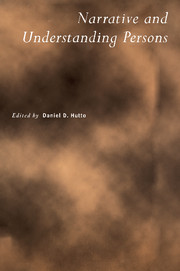Book contents
- Frontmatter
- Contents
- List of Contributors
- Notes on Contributors
- Narrative and Understanding Persons
- Framing Narratives
- The Narrative Practice Hypothesis: Origins and Applications of Folk Psychology
- Dramatic Irony, Narrative, and the External Perspective
- Episodic Ethics
- On the Distance between Literary Narratives and Real-Life Narratives
- Reasons to be Fearful: Strawson, Death and Narrative
- Stories, Lives, and Basic Survival: A Refinement and Defense of the Narrative View
- Self and Other: The Limits of Narrative Understanding
- Pathologies in Narrative Structures
Framing Narratives
Published online by Cambridge University Press: 04 May 2010
- Frontmatter
- Contents
- List of Contributors
- Notes on Contributors
- Narrative and Understanding Persons
- Framing Narratives
- The Narrative Practice Hypothesis: Origins and Applications of Folk Psychology
- Dramatic Irony, Narrative, and the External Perspective
- Episodic Ethics
- On the Distance between Literary Narratives and Real-Life Narratives
- Reasons to be Fearful: Strawson, Death and Narrative
- Stories, Lives, and Basic Survival: A Refinement and Defense of the Narrative View
- Self and Other: The Limits of Narrative Understanding
- Pathologies in Narrative Structures
Summary
Marianne Dashwood was well able to imagine circumstances both favourable and unfavourable to her. But for all her romantic sensibility she was not able to imagine these things from anything other than her own point of view. ‘She expected from other people the same opinions and feelings as her own, and she judged of their motives by the immediate effect of their actions on herself.’ Unlike her sister, she could not see how the ill-crafted attentions of Mrs. Jennings could derive from a good nature. And when Elinor had to explain her troubles with Edward Ferrars, she knew that Marianne would feel it as a reminder of her own relations to Willoughby, judging Edward's behaviour as equivalent to that of Willoughby himself. Without the capacity to shift her point of view, Marianne can get no ironic distance from herself; she cannot see the unrealism of her later determination ‘to live solely for my family’.
Simplifying a good deal, we can say that imaginative abilities vary on two dimensions. Imagination gives us the capacity to engage with things and events which are not (at least not yet) actual. Imagination also gives us ways of responding to things in the world, and to things that may be offered us to imagine in this first sense, from a perspective not our own. Marianna's excess of the one and lack of the other dramatically narrow her understanding; her's is a vividly imagined and highly egocentric world.
- Type
- Chapter
- Information
- Narrative and Understanding Persons , pp. 17 - 42Publisher: Cambridge University PressPrint publication year: 2007
- 10
- Cited by



